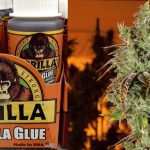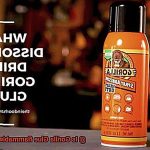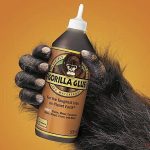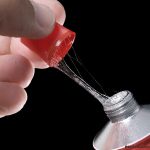Picture this: you’ve got a favorite plastic item that’s seen better days, and you’re on a mission to bring it back to life. That’s where Gorilla Glue swoops in, claiming to be the ultimate fixer-upper for all sorts of surfaces. But before you dive headfirst into your DIY project, there’s one burning question: can Gorilla Glue actually be used on plastic?
In this no-nonsense blog post, we’ll break down the nitty-gritty of using Gorilla Glue on plastic. We’ll discuss the pros and cons, dish out some essential tips for your safety and the longevity of your repaired item, and separate fact from fiction.
Let’s start with the good stuff. Gorilla Glue is famous for its insane bonding strength, making it a go-to choice for joining materials like wood, metal, ceramic, and yes – even certain plastics. It’s versatile, durable, and beloved by both DIY fanatics and professionals alike. Plus, it’s waterproof and weather-resistant, perfect for outdoor projects that need some extra oomph.
But hold up – there are a few things you need to know before diving in with Gorilla Glue on plastic. While some plastics (we’re looking at you polyethylene and polypropylene) are generally resistant to most adhesives due to their low surface energy, Gorilla Glue is specially formulated to bond a wide range of materials.
Here’s the catch: when using Gorilla Glue on plastic, foaming can occur during curing if you’re not careful. This means you might end up with unsightly blobs or bubbles if you don’t apply it just right. And here’s another thing – as it dries, this glue expands. So if you’re working with smaller plastic items or delicate areas where excess adhesive could ruin the look, use it sparingly.
Now, let’s talk about potential risks. Some plastics just don’t mix well with Gorilla Glue. Certain chemicals in the glue can cause discoloration, cracking, or even structural damage to certain types of plastic. For instance, polystyrene foam and PVC (polyvinyl chloride) should never come into contact with Gorilla Glue – they’re like oil and water.
Safety first. Like any adhesive worth its weight, Gorilla Glue contains isocyanate compounds that can irritate your skin,
What is Gorilla Glue?
Contents
- 1 What is Gorilla Glue?
- 2 Does Gorilla Glue Work on Plastic?
- 3 Types of Plastics that Gorilla Glue Works On
- 4 Preparing the Plastic Surface for Gorilla Glue
- 5 Applying Gorilla Glue to Plastic
- 6 Clamping or Applying Pressure to Bonded Surfaces
- 7 Advantages of Using Gorilla Glue on Plastic
- 8 Disadvantages of Using Gorilla Glue on Plastic
- 9 Conclusion
In the world of adhesives, there is one glue that stands tall above the rest – Gorilla Glue. This incredible adhesive has gained a reputation for its remarkable strength and versatility. Whether you’re a DIY enthusiast or a professional craftsman, Gorilla Glue is a must-have in your toolbox.
The Power of Polyurethane:
At the heart of Gorilla Glue lies the power of polyurethane. This unique formulation sets it apart from other adhesives on the market. With its polyurethane-based composition, Gorilla Glue can bond with a wide range of materials, including wood, stone, metal, ceramics, and select plastics. No matter what project you’re tackling, Gorilla Glue provides the strength and flexibility needed to get the job done.
Variants for Every Need:
Gorilla Glue offers a variety of formulations to suit specific applications. Here are some notable variants:
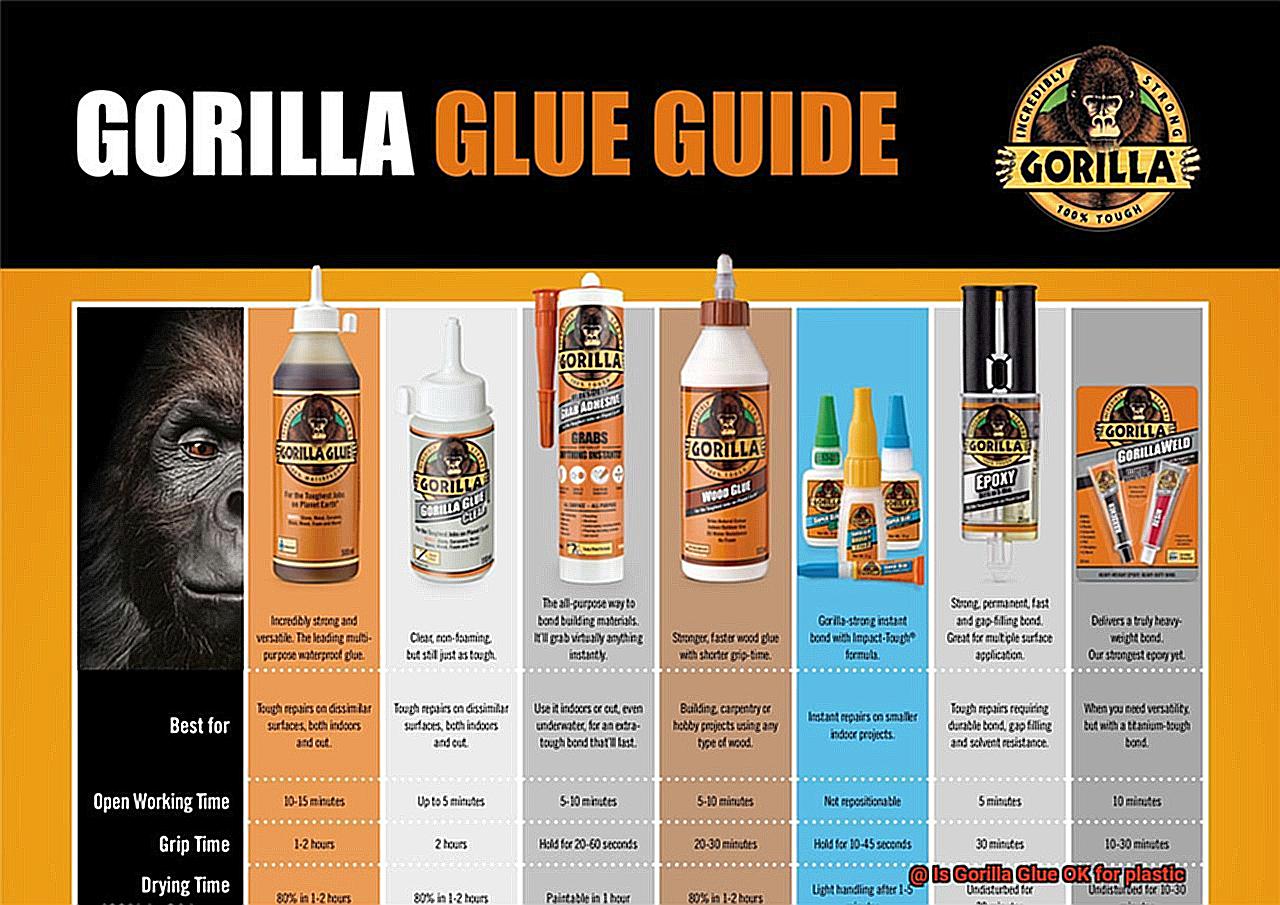
- Original Gorilla Glue: This moisture-activated adhesive expands as it cures, creating a robust and reliable bond. Perfect for porous materials like wood, fabric, foam, and certain plastics.
- Gorilla Super Glue: Need quick and secure bonding? Look no further than Gorilla Super Glue. This instant adhesive bonds rapidly on non-porous surfaces like metal, rubber, ceramics, and select plastics.
- Gorilla Wood Glue: Craftsmen rejoice. Gorilla Wood Glue is specially designed for woodworking projects. It provides a strong bond for joining pieces of wood together and is resistant to water, heat, and solvents.
- Gorilla Epoxy: For heavy-duty applications or exposure to harsh conditions, Gorilla Epoxy is the go-to choice. This two-part adhesive, comprising resin and hardener, is ideal for bonding metal, ceramic, glass, plastic, and more.
A Note on Plastic Bonding:
While Gorilla Glue excels at bonding many plastics, it’s important to understand that not all plastics are created equal. Some plastics, like PVC and acrylic, work exceptionally well with Gorilla Glue due to their smooth surfaces. However, other plastics, such as polypropylene or polyethylene, may not bond as effectively.
To determine compatibility, always test Gorilla Glue on a small, inconspicuous area of the plastic surface. Properly clean and lightly roughen the surface for optimal adhesion. Remember, less is more when it comes to applying Gorilla Glue on plastic – excessive amounts can weaken the bond.
Does Gorilla Glue Work on Plastic?
When it comes to adhesive superheroes, Gorilla Glue reigns supreme. Renowned for its unmatched strength and versatility, it is the go-to solution for all your bonding needs. But can this mighty adhesive conquer the world of plastic? Join me on a journey into the realm of Gorilla Glue and its compatibility with plastic, as we unravel the factors that determine whether this dynamic duo is a match made in heaven or a recipe for disaster.
The Plastic Conundrum:
Plastics come in a myriad of forms, each with its unique properties. To understand their compatibility with Gorilla Glue, it’s crucial to delve into their characteristics. PVC, acrylic, polycarbonate, and ABS plastics have surfaces that harmonize well with Gorilla Glue due to their adhesion-friendly properties. However, beware of polyethylene and polypropylene, as their low surface energy makes them more resistant to bonding with most adhesives, including our beloved Gorilla Glue.
Prepare for Success:
Before embarking on a bonding adventure, take a moment to prepare the stage for optimal results. Cleanse the plastic surface meticulously, banishing any dirt or grease that could sabotage the adhesive’s grip. Remember, a clean surface is the foundation for a strong bond.
Follow the Instructions:
Gorilla Glue knows best when it comes to achieving an unbreakable union. Follow their instructions diligently for prime results. Apply the adhesive in a thin layer, ensuring even coverage on both surfaces. To hold the bond securely during curing, embrace the power of clamping or pressure – they’re your allies in this sticky endeavor.
Beware of Expansion:
While Gorilla Glue’s expanding nature can be a boon for certain materials, it can pose challenges when working with plastic. Excessive application could lead to foaming and potential damage to the plastic surface. Exercise caution, my friend, and apply Gorilla Glue sparingly to avoid any unwanted surprises.
The Importance of Testing:
Before embarking on a grand bonding project, conduct a small-scale test on an inconspicuous area of the plastic surface. This simple act of precaution will reveal whether Gorilla Glue and your chosen plastic are meant to be or if adjustments need to be made before committing fully.
Types of Plastics that Gorilla Glue Works On
Today, we embark on a journey to unlock the secrets of Gorilla Glue and discover which types of plastics it can magically unite. So, let’s dive in and explore the wonders of this versatile adhesive.
ABS Plastic – The Heroic Companion:

When it comes to fixing action figures or mending car parts, Gorilla Glue’s trusty sidekick is ABS plastic. Known for its strength and durability, ABS plastic is often found in toys and shiny automotive components. Gorilla Glue forms a powerful bond with ABS, ensuring that your repairs stand the test of time.
PVC Plastic – The Helpful Ally:

Imagine those sturdy plumbing pipes or the sleek vinyl flooring in your kitchen; they owe their strength to PVC plastic. Gorilla Glue forms a strong connection with PVC, making it an ideal choice for joining or repairing PVC surfaces. Whether you’re tackling a plumbing project or fixing your favorite vinyl flooring, Gorilla Glue is your reliable ally.
Polycarbonate – The Transparent Guardian:
From safety goggles to gleaming car headlights, polycarbonate is the go-to material for providing both clarity and durability. Gorilla Glue effortlessly bonds with polycarbonate, ensuring a crystal-clear connection that endures even the harshest conditions. Count on Gorilla Glue to repair or join polycarbonate items with ease.
Polystyrene – The Protective Shield:
Ever received a package filled with those white foam peanuts? That’s polystyrene, a lightweight plastic widely used in packaging materials. Gorilla Glue has no trouble bonding with polystyrene, but remember to clean any dirt or grease from the surface before applying the adhesive. With Gorilla Glue’s help, you can securely protect your belongings with ease.
Tricky Plastics: Polyethylene and Polypropylene:
Now, let’s meet the challenging duo – polyethylene and polypropylene. These plastics have low surface energy, making it more difficult for adhesives to establish a strong bond. However, fear not. Gorilla Glue offers a specialized product called “Gorilla Super Glue Gel” that works its magic on these low-energy plastics. When tackling projects involving polyethylene or polypropylene, reach for this remarkable adhesive.
Preparing the Plastic Surface for Gorilla Glue
When it comes to bonding plastic surfaces, Gorilla Glue is renowned for its strength and durability. However, achieving a strong bond requires proper preparation of the plastic surface. In this article, we will guide you through the essential steps to ensure the best results when using Gorilla Glue on plastic.
Step 1: Thoroughly Clean the Plastic Surface
To start, eliminate any hindrances to bonding by removing dust, dirt, or grease from the plastic surface. Use a clean cloth or paper towel to wipe away loose debris that could compromise the adhesive.
Step 2: Use a Mild Detergent or Soap Solution
Take cleaning a step further by preparing a mild detergent or soap solution. Scrub the plastic surface gently with a soft brush or sponge, ensuring every nook and cranny is covered. Rinse thoroughly with water to remove any lingering residue.
Step 3: Removing Stubborn Dirt or Grease
For stubborn dirt or grease on the plastic surface, consider employing stronger cleaning agents like rubbing alcohol or acetone. However, exercise caution as these substances can potentially damage certain types of plastic. Test them on a small, inconspicuous area before proceeding.
Step 4: Roughen the Surface with Sandpaper
To create an optimal bonding surface for Gorilla Glue, lightly sand the plastic using fine-grit sandpaper. This process eliminates any glossy or smooth finish and provides a rougher texture for the glue to adhere to. Remember to wipe away all dust or debris after sanding.
Step 5: Applying Gorilla Glue
Now that the plastic surface is cleaned and prepared, it’s time to apply Gorilla Glue. Follow the instructions on the glue packaging diligently for optimal results. Apply a thin layer of glue, ensuring complete coverage of the bonding area. Clamp or hold the surfaces firmly together until the glue dries.
Closing Thoughts:
By following these steps, you can ensure a strong and durable bond when using Gorilla Glue on plastic surfaces. Prioritize safety by testing any cleaning agents on a small area before applying them to the entire surface. With proper preparation, Gorilla Glue will work its magic, providing you with a reliable bond that withstands the test of time. Happy gluing.
Applying Gorilla Glue to Plastic
Are you tired of flimsy plastic repairs that just don’t hold up? Well, fret no more. In this guide, we’ll explore the world of Gorilla Glue and its potential for bonding plastic surfaces. While it may not be specifically designed for plastic, with the right techniques and precautions, you can achieve incredible results. So buckle up and get ready to unleash the power of Gorilla Glue.
Choosing the Right Plastic:
Before we dive into the gluing process, it’s important to understand that not all plastics are created equal. Gorilla Glue works best on rigid plastics such as PVC, ABS, and acrylic. These materials have smooth surfaces that allow for better adhesion. If you’re unsure about the type of plastic you’re working with, it’s always a good idea to test the adhesive on a small, inconspicuous area first.
Step 1: Prepare the Plastic Surface:
To ensure a strong bond, proper surface preparation is key. Start by giving the plastic a thorough cleaning using warm soapy water. This will remove any dirt, dust, or grease that could hinder the bonding process. For stubborn residues, a gentle scrub with a soft brush should do the trick. After cleaning, wipe down the surface with rubbing alcohol to remove any remaining contaminants.

Step 2: Roughen Up the Surface:
Now it’s time to create some grip for the glue. Grab some sandpaper or a fine-grit abrasive pad and gently scuff up the plastic’s surface. This step may seem counterintuitive, but those tiny scratches actually provide more surface area for the glue to adhere to. Be careful not to overdo it – a light roughening is all that’s needed.
Step 3: Apply Gorilla Glue with Precision:
Now comes the exciting part – applying Gorilla Glue. Remember, less is more in this case. A thin layer of glue is all you need for a solid bond. Too much glue can result in messy and uneven bonding. To ensure even application, you can use a small brush or a toothpick to spread the glue across the plastic surface. Take your time and be precise.
Step 4: Clamp and Let It Cure:
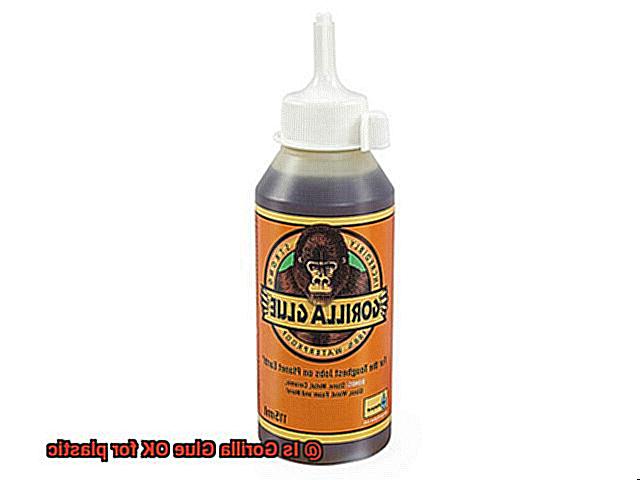
Once you’ve applied the glue, it’s time to bring those plastic parts together. To achieve a strong and durable bond, apply pressure by clamping or holding them firmly in place. This helps ensure that there are no gaps between the surfaces and allows the glue to do its magic. If clamping is not an option, you can use heavy objects to keep the parts in place. Leave everything undisturbed until the glue has fully cured. The curing time can vary depending on factors such as temperature and humidity, so be sure to refer to the instructions provided by the manufacturer for specific guidelines.
Step 5: Remove Excess Glue and Admire Your Work:
Hooray. The waiting game is over, and your glued plastic surfaces are now ready to shine. But before you celebrate, don’t forget to remove any excess glue carefully. Use a sharp blade or sandpaper to gently scrape away the excess without damaging the plastic surface. Take your time with this step to ensure a clean and polished final result.
Clamping or Applying Pressure to Bonded Surfaces
When it comes to bonding surfaces with Gorilla Glue, clamping or applying pressure is a crucial step, especially when working with plastic materials. Gorilla Glue is a polyurethane-based adhesive that requires moisture to activate and create a strong bond. Applying pressure helps distribute the adhesive evenly across the surface and ensures optimal contact between the glue and the plastic.
So, why is clamping or applying pressure so important? Let’s explore the details.
First and foremost, finding the right amount of force is key. Too much pressure can squeeze out excess glue, while too little pressure may result in weak or incomplete bonds. Striking the perfect balance is essential for success.
The duration for which pressure needs to be applied depends on the specific Gorilla Glue product being used. It’s important to carefully read and follow the instructions provided by the manufacturer for best results. Whether it’s a quick-drying formula or one that requires longer curing time, patience is a virtue when it comes to bonding surfaces.
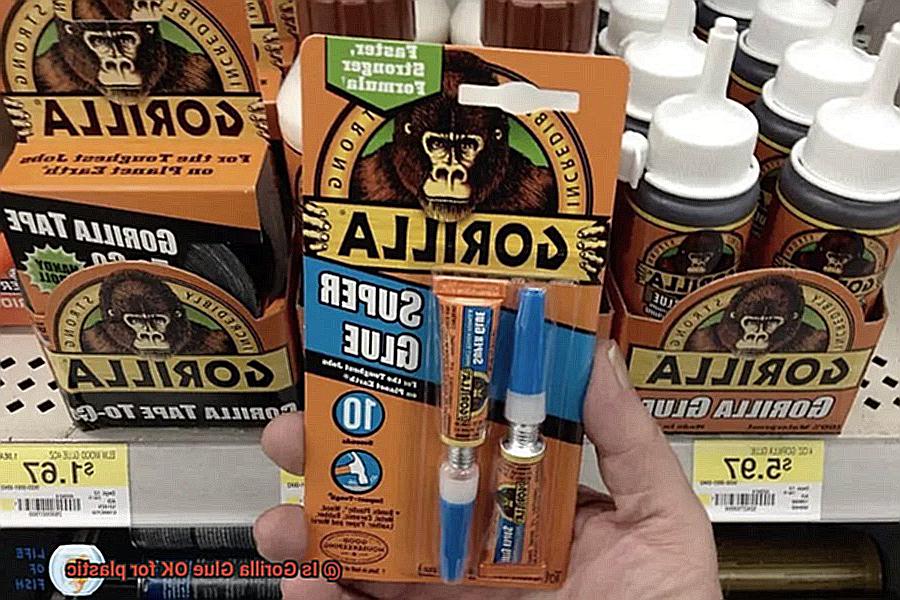
Now, let’s talk about how to go about clamping or applying pressure. There are several options available. Clamps or other tools can be used to apply pressure to the bonded surfaces. It’s crucial to choose clamps or tools that are appropriate for the size and shape of your project. Additionally, consider the flexibility of plastic and its potential for warping under pressure. Using clamps or tools that distribute pressure evenly across the surface can help minimize any distortion and ensure a strong bond.
If clamping isn’t feasible for your project, using weights or heavy objects can be an alternative solution. This method works well for smaller projects or areas where clamps cannot be easily applied. Just remember to evenly distribute the weight to avoid any uneven bonding.
However, it’s important to note that not all plastics are suitable for bonding with Gorilla Glue. Some plastics, such as polyethylene and polypropylene, have low surface energy and require special primers or adhesives designed specifically for these materials. Before applying Gorilla Glue to plastic, it’s always a good idea to perform a small test on a hidden or inconspicuous area to ensure compatibility and desired results.
Lastly, after clamping or applying pressure, give the glue sufficient time to cure. The curing time can vary depending on factors such as temperature and humidity, so it’s advisable to refer to the manufacturer’s instructions for specific guidelines. Rushing the curing process may result in weaker bonds and compromise the longevity of your project.
Advantages of Using Gorilla Glue on Plastic
Look no further. Gorilla Glue is here to save the day. With its exceptional bonding capabilities, versatility, durability, and user-friendly nature, Gorilla Glue has become the go-to adhesive for plastic enthusiasts. In this article, we will explore the advantages of using Gorilla Glue on plastic, revealing the secret to creating long-lasting bonds that withstand the test of time.
Advantage 1: Unmatched Bonding Strength
Gorilla Glue is renowned for its ability to create strong and durable bonds. When applied to plastic surfaces, it forms an incredibly sturdy connection that can withstand frequent use and exposure to various elements. Say goodbye to flimsy repairs and hello to a bond that holds up even under extreme conditions.
Advantage 2: Versatility at Its Finest
One size does not fit all when it comes to gluing plastics, but fear not. Gorilla Glue is a versatile adhesive that seamlessly works on a wide range of plastic materials. From polyethylene to PVC and everything in between, this all-in-one solution eliminates the need for multiple adhesives, saving you time and money.
Advantage 3: Waterproof Wonder
Plastic objects often encounter moisture or water, making waterproof properties a crucial aspect of any adhesive. Gorilla Glue rises to the occasion with its exceptional waterproof formula. It ensures that your bond remains strong and intact, even in damp environments. Now you can confidently repair your water-damaged plastic items without worry.
Advantage 4: Filling in the Gaps
Uneven or irregular plastic surfaces can pose challenges when trying to achieve a secure bond. Luckily, Gorilla Glue’s expanding properties come to the rescue. As it cures, it expands, filling in gaps and providing added strength to the bond. No more worries about weak spots or compromised repairs – Gorilla Glue has got you covered.
Advantage 5: Temperature Resistance
Plastic materials are often exposed to temperature fluctuations, which can weaken bonds over time. However, Gorilla Glue is resistant to these changes, making it suitable for both hot and cold environments. Whether you’re repairing a plastic object in a scorching summer or a freezing winter, Gorilla Glue will maintain its integrity and keep your materials securely bonded.
Advantage 6: Ease of Use
Gorilla Glue’s user-friendly nature is the icing on the cake. With its convenient packaging and applicator tip, applying the glue precisely and controlled is a breeze. Plus, its fast curing time means you won’t have to wait around for hours on end. Within just 1-2 hours, your project will be ready to go, allowing you to tackle more tasks in less time.
Disadvantages of Using Gorilla Glue on Plastic
When it comes to adhesive superpowers, Gorilla Glue undoubtedly takes the crown. This mighty glue is known for its incredible strength and versatility, making it a go-to choice for many DIY enthusiasts. However, like any superhero, Gorilla Glue has its kryptonite. When it comes to using it on plastic, there are a few disadvantages that should be considered. In this blog post, we’ll explore the potential pitfalls of using Gorilla Glue on plastic and why it’s important to choose the right adhesive for your plastic projects.
Expansion Troubles:
One major disadvantage of using Gorilla Glue on plastic is its tendency to expand as it cures. While this expansion may not be an issue for other materials, it can spell disaster for plastic. Thin or delicate plastic materials are especially susceptible to cracking or warping when exposed to the expanding glue. So, if you’re working with such materials, it’s best to steer clear of Gorilla Glue.
Messy Residue:
Another downside of using Gorilla Glue on plastic is the messy residue it leaves behind. As the glue expands, it tends to spread out, resulting in a visible and often difficult-to-remove residue. This can be quite unsightly and may require additional cleaning or sanding to achieve a smooth finish on your plastic project.
Lack of Flexibility:
Plastic materials often require some flexibility to withstand regular use or movement. Unfortunately, Gorilla Glue is not known for its flexibility once it has cured. This lack of flexibility can lead to cracked or broken plastic parts over time, compromising the integrity of your project.
Compatibility Issues:
Gorilla Glue may be a powerful adhesive, but it’s not specifically formulated for use on plastics. While it may bond well with certain types of plastic, it may not work as effectively on others. It’s crucial to consider the type of plastic you’re working with and whether Gorilla Glue is suitable for that particular material. Choosing the wrong adhesive can result in weak bonds or even complete failure.
Long Curing Time:
Patience is a virtue, they say. Well, when it comes to using Gorilla Glue on plastic, you’ll need plenty of it. Gorilla Glue has a long curing time, typically taking several hours to fully cure and even longer for maximum strength to be achieved. This can be quite inconvenient when working on plastic projects that require quick bonding or immediate use.
bG60VfP5Z84″ >
Also Read: Does Gorilla Glue Work on Plastic?
Conclusion
When it comes to the question of whether Gorilla Glue is suitable for plastic, the answer is a resounding yes. This powerful adhesive has proven time and time again that it can bond various materials, including plastic, with remarkable strength and durability. Whether you’re repairing a broken toy or assembling a DIY project, Gorilla Glue provides a reliable solution that will hold your plastic pieces together securely.
But what makes Gorilla Glue so effective for plastic? It all comes down to its unique formulation. This adhesive is specially designed to create an incredibly strong bond on different surfaces, including plastics of various types. Its versatility allows it to work wonders on everything from PVC pipes to acrylic sheets.
Not only does Gorilla Glue provide exceptional bonding strength, but it also offers excellent resistance to moisture, heat, and chemicals. This means that once you’ve applied this adhesive to your plastic surfaces, you can trust that it will withstand the test of time and remain intact even in challenging conditions.
Furthermore, applying Gorilla Glue to plastic is a breeze. Its thick consistency ensures easy application without any messy drips or spills. Simply apply a thin layer of glue onto the surface, join the plastic parts together firmly, and let the glue work its magic. Within minutes, you’ll have a sturdy bond that will hold up under pressure.
It’s important to note that not all adhesives are suitable for plastic. Some may not adhere properly or may even damage the material. That’s why choosing a reliable option like Gorilla Glue is crucial when working with plastics.
In conclusion, if you’re wondering whether Gorilla Glue is OK for plastic, rest assured that it’s more than just OK—it’s fantastic. With its impressive bonding strength, resistance to various elements, and easy application process, this adhesive is a go-to choice for any plastic-related projects. So go ahead and grab yourself some Gorilla Glue for all your plastic bonding needs.


